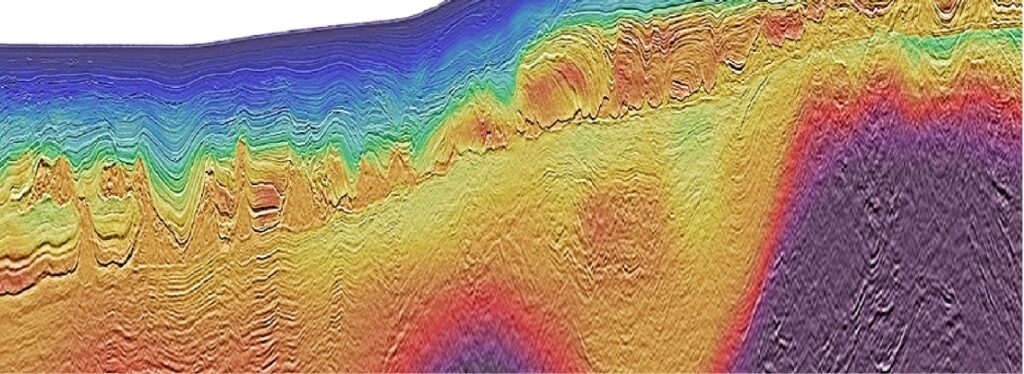
High accurate estimation of velocity (=PSDM)
OGF’s velocity model building technology has all the tools needed to quickly build an accurate velocity model for time or depth imaging. OGF’s SPArK toolkit enables quick, effective velocity model building for any geological setting. SPArK can tomographically model build in offset and angle domain and can build not only velocity models but anisotropy*1 and Q models*2 as well.
The OGF model building toolkit also incorporates FWI (Full Waveform Inversion)*3 technology, which allows us to add more detail to resolve complex velocity issues.
Accurate, reliable imaging of the subsurface requires an appropriate choice of migration algorithm. The OGF imaging suite includes a full complement of industry leading imaging algorithms. These algorithms include Kirchhoff time*4, Kirchhoff depth*5, Wave Equation Migration (WEM)*6, Reverse Time Migration (RTM)*7, and Least-Squares Migration (LSM)*8. All OGF migration algorithms are Q enabled.

*1 Anisotropy refers to the phenomenon where the physical properties of a material vary depending on the direction. In geophysical exploration, it means that seismic wave velocities differ in various directions, which must be considered to accurately understand subsurface structures.
*2 The Q model represents how much energy subsurface rocks or sediments absorb and how this absorption causes seismic wave attenuation. In geophysical exploration, the Q model is used to account for wave attenuation and helps estimate the properties of subsurface masses and fluids.
*3 FWI (Full Waveform Inversion) is a technique that uses the entire recorded seismic waveform to accurately estimate subsurface structures. By incorporating details of both the amplitude and phase of seismic waves, FWI produces higher-resolution subsurface models compared to traditional methods, making it essential in oil and gas exploration.
*4 Kirchhoff Time Migration is a seismic data processing technique that estimates subsurface structures based on the arrival times of reflected waves. It is widely used for reconstructing reflectors and is known for its simplicity and computational efficiency, based on the wave equation.
*5 Kirchhoff Depth Migration is a technique that processes seismic data based on depth to create more accurate images of subsurface structures. It is particularly effective in areas with complex geological formations, accounting for wave refraction and velocity variations to achieve high-precision migration.
*6 Wave Equation Migration models the propagation of seismic waves based on the wave equation to create more accurate representations of subsurface structures. It offers better resolution compared to traditional Kirchhoff migration, particularly in areas with complex geological formations.
*7 Reverse Time Migration (RTM) simulates seismic waves in reverse time to produce accurate imaging of subsurface structures. It is particularly effective for deep or complex formations and provides highly accurate results, though it requires significant computational resources due to its reverse calculation approach.
*8 Least-Squares Migration is a technique that minimizes the difference between observed data and model-predicted data. By reducing errors in the data, this method allows for more accurate subsurface imaging and is particularly useful in high-quality data analysis.
Broadband Processing (=improving resolution)
The bandwidth of marine towed streamer acquisition is reduced by the presence of ghosts. However, OGF technology can recover the frequencies lost to ghosts. Two types of method are offered to address the ghosts – acquisition-based and processing-based solutions.
OGF’s acquisition-based solution uses TANSA’s dual-sensor Geostreamer technology to completely recover the energy at the receiver notches (bandwidth with missing data). This energy is otherwise lost in single sensor acquisition.
OGF also utilizes a processing-based solution to model the ghost functions, for which compensation can then be applied. There are limitations to this technology as there are many assumptions to the properties of source and to the sea state. Processing-based deghosting solutions can be applied to both multi-sensor acquisition and conventional streamer data. This means that the benefits of modern technology can be applied to vintage datasets via reprocessing, bringing a new perspective to older data.
OGF offers a complete set of deghosting solutions*9 comprising both acquisition-based and processing- based techniques or a combination of both.
*9 Deghosting is the process of removing “ghost” reflections, which are unwanted signals in seismic data. This technique improves the quality of the seismic signal, particularly in marine exploration, leading to more accurate subsurface imaging.
